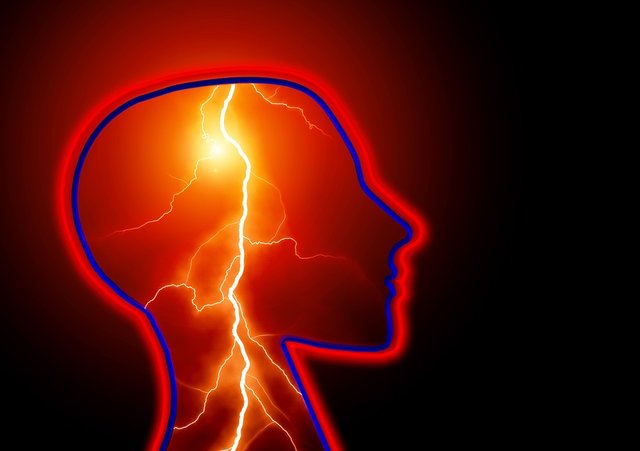Medical Myths: Can You Swallow Your Own Tongue During a Seizure?
Most of us have an idea of what a seizure is like, or maybe we have even seen or suffered one; involuntary muscle movements, sometimes so violent that they resemble more a case of demonic possession (usually not the case, unless the affected person starts speaking in Latin. If that happens, you may want to check this instead. Holy water not included.). In case we see someone having a seizure in front of us, we know that it is time to be the hero, and hold the patient while we put something, like a wallet, in his mouth to prevent him from biting or swallowing his tongue. We do not know exactly from where we know that, but that's the right thing to do, correct...?

Well, as in many other things (it seemed so real that babies were brought by storks, I know), we have been lied to. Who would say that TV shows are not a good source of medical knowledge?
What really needs to be done will come a little later, first, let's talk a bit about exactly what a seizure is, since even this is not very clear among the general public. To begin with, there are two classifications of seizures: the partial seizures, which only affect one area of the brain, and whose pathological manifestations depend on the acts performed by that area. In this type of seizure there is no loss of consciousness, that is, the patient does not faint and can usually remember the convulsive episode, although it is possible that there are alterations in the state of consciousness, such as confusion or disorientation. People with this type of seizure usually do not present very dramatic manifestations; These are usually limited to staring at nothing in specific, a shaking of the lips, speaking in an unintelligible way, or moving your arms and legs abnormally (the perfect excuse for when you wave at someone by mistake). It can be difficult to differentiate this condition from common drunkenness, or from the beginning of a stroke, but generally this type of crisis is of short duration, and it is unlikely to cause the affected to call his ex saying that he misses her.
Then we have the generalized seizures, which affect a wide area of the brain, and are usually what we think about when we talk about seizures: loss of consciousness, involuntary muscle movements similar to those of your friend who thinks he knows how to breakdance after a few drinks, and loss of memory of the event and sometimes even of the previous moments. There are many types of generalized convulsive seizures, but the most common (and those that have to do with the topic at hand, come on, we are deviating from the point of the article) are the tonic-clonic seizures, those in which the muscles contract (tonic part) and then they relax (clonic part), creating that typical movement similar to that of a fish out of water that we all know. During these seizures, it is common for the sufferer to clench his teeth, foam at the mouth, and can even bite his tongue or hit his head during the crisis.

But, is it true that you have to try to force something inside their mouth to prevent possible death by suffocation or hemorrhage?
The truth is that this method so often seen on television ** _is not effective in the prevention of complications _**, and in fact if one tries it could make things worse for both the affected and for you. You see, during seizures it is common for the person to open and close their mouth uncontrollably; after all, this movement is also controlled by muscles. And taking into account that the bite of a human can exert 171 pouds of force per square centimeter, you can begin to imagine the consequences if the patient decides to close his mouth with all his strength just when you have your fingers inside it, trying to put your wallet to prevent him from biting his tongue (besides, the taste of leather is quite unpleasant), or what could happen to his teeth if you try to introduce something more solid. And not only this; trying to open the mouth forcibly while the affected is trying to close it can dislocate or even break the jaw, turning those 2-3 minutes of convulsions into possibly several days eating through a straw. To finish cementing this myth, it is physically impossible to swallow your own tongue, so while it is common for patients to bite their tongues during seizures, it is usually not very serious, and trying to force some object into their mouth for them to bite will only make everything worse, in addition to the fact that the danger of suffocating with his tongue is non-existent, although this can happen with any object you introduce in his oral cavity.

The final verdict for this medical myth: FALSE
So, what can we do to help someone who is convulsing?
Having left it clear that the mouth is not to be touched, proper handling consists in trying to protect the affected person from the initial fall, although this can be difficult. Once the tonic-clonic movements begin, the best thing to do is to put the patient on his side, and although it may seem counter-intuitive, do not prevent him from moving. Basically, you have to treat it like a bad hangover or an acid trip; let the affected person wait out the manifestations of the crisis, which usually occurs in about 3 minutes, while protecting his head from possible blows and holding him gently to keep him from hitting the ground or nearby objects, and if necessary, you can loosen the clothes around the neck to avoid a possible suffocation.
It´s also important to note that this is not the only type of generalized seizure, there are also the so-called absence crisis, which may not be diagnosed for years because they are short-lived, the patient does not remember them, and the manifestations are usually extremely subtle for other people watching. In addition, it is important to discover and treat the cause of all types of seizures; either with drugs or with other therapeutic methods. This topic goes much beyond what was discussed here, if you want to write more about it, feel free to leave your opinion below and I will make sure to explain the individual types of seizures, along with their manifestations, diagnosis, and treatment, all as simple as possible, and with the same style as the one used here. But later, of course; Dr. House is about to begin.
References:
- Beers, Mark H., et al. The Merck Manuals of Diagnosis and Therapy, 11th ed., 2007.
- Kasper, D. L., Fauci, A. S., et al. Harrison´s Principles of Internal Medicine, 19th ed., 2016.
Congratulations @mike961, your post has been selected by the @asapers for a resteem and a feature in our brand new curation post. Issue 53
What does this mean for you? Well first an upvote from some members of the team, we are no @curie or @ocd but who is going to be unhappy with some extra upvotes. Also each post featured in the article will receive a 10% share of the SBD generated from the curation post.
Keep up the great work and please consider supporting the @asapers with an upvote and/or a resteem on the post you feature in. Please wait seven days for payout.
Your friendly @asapers
Giving back A.S.A.P
This is such an easy to follow and understand write on a largely misunderstood problem.
The public response to a person who suffers a seizure is always to withdraw, many find it a repelling occurrence, while those who who move in to attend to the victim have not the best knowledge of how to.
Your write here is original (from the way you tell of it), it is relevant as it focuses on an important community issue, and you write it to good depth.
That said,
This Post has now been chosen and will be featured in the 9th Edition of Xposed. Hopefully it will bring you some much needed exposure and rewards which your post deserves.
For more details on this project, read Xposed Introduction
Thanks a lot! I've read about your project and I found it very helpful to us beginners, you have a new community member ;) and indeed I wrote the wrong tag, guess I'll have to settle with putting it as the second tag, thanks as well for making me notice that
The pleasure is mine, @mike961. You wrote well on a good subject.
Meanwhile the Feature post is out now. Here is a link.
Our tongue can suffocate us when we were unconscious, though. Nice article!
That much is true, although is almost impossible that it happens during a seizure, it's more common when there's macroglossia (abnormal growth of the tongue)
I honestly had no idea about it being a myth although the chances of me actually holding someone's tongue in case of a seizure are pretty low. I would actually call emergency services and be sure I stabilize the person. I am disappointed I haven't followed any real first aid training.
It's always good to have at least some basic first aid knowledge, you never know when you're going to need it. You've just gave me the idea of writing some posts about basic first aid tips and advices, anything to help you help others ;)
Followed, I know the basics but there are classes which also would make me practice. Which would be invaluable, I know the theory but I will read your guide if you write it though! :D
There is no harm carrying this extra knowledge around with one. Even though there is nothing much one can do, other than prevent further injury if you can; it's useful.
Congratulations on your inclusion in Asapers!
Thanks! I'll try to keep creating useful content, maybe someday it will help save a life